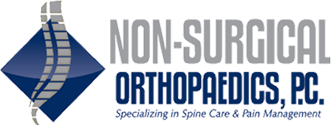Best Ways to Minimize Lower Back Pain at Work

April 2021
Approximately eight percent of American adults struggle with chronic back pain. Some estimates suggest Americans and their health care providers spend $50 billion a year to manage low back pain.
Back pain can originate from a variety of causes, including things like excessive inactivity, bad posture and repetitive stress injuries. Although backpain is frequently associated with aging, anyone, at any age, can develop back pain.
Pay Attention to Your Body
When going about your daily tasks, you may not realize the kind of strain and exertion you are putting on your body. Making minor adjustments to your routine, being vigilant of your posture and listening to your body may help you avoid back injuries.
Posture is important when you are standing and sitting down. When standing, make sure your feet are spread evenly apart on the floor and your weight is distributed evenly. When sitting, make sure your chair's height is low enough that your feet are flat on the ground. Also avoid keeping wallets or other items in your back pocket. Sitting on an overstuffed wallet over a long period of time can throw off your spine's alignment and cause back pain.
Additionally, pay attention to your posture. The tighter your core, the more support your back has. Being slouched in a chair and hunched over a desk can cause significant lower back pain.
If your job involves lifting heavy objects, make sure you are doing so correctly. Lift with your legs, tighten your core and do not twist your back when lifting heavy items. These are especially important tips when it comes to repetitive tasks. If you are carrying several heavy items daily, be sure to alternate between heavy and light loads.
The single most common cause of lower back pain is a torn muscle or ligament. Strains and sprains can happen suddenly or slowly over time. Paying attention to your body’s movement and positioning can prevent serious injuries such as herniated lumbar discs, degenerative disc disease, joint dysfunction and spinal stenosis.
Don’t ignore lower back pain once it starts. Speak with a doctor or begin taking restorative measures to start the healing process.
Exercises and Movements
Inactivity can contribute to back pain. Inadequate back support and stiffness are often culprits of lower back pain in individuals who sit at a desk all day.
To help prevent back pain, start by strengthening your back muscles. Exercises like swimming can strengthen and stretch your back muscles, offering more support daily. Also consider performing activities that improve balance to promote an even stance.
Sitting or standing for prolonged periods should ideally be broken up with body movement. Getting up throughout the day and taking a walk or stretching relieves tension.
Adjust your positioning regularly. Additional back support, like backrests or steps below your desk for your feet, can help you maintain good posture and keep you focused on your body. Try doing neck stretches, upper body stretches and lower body stretches.
Check out these stretches for workplace movement if you find it hard to get away from your desk during the workday.
Non-Surgical Treatments
Managing persistent back pain sometimes requires medical intervention of some type. Surgery is certainly not the only solution for chronic back pain. Invasive surgeries are costly, require long recovery periods and are not always practical.
Non-surgical options are often effective, affordable and more practical for the average American with everyday back pain. Non-Surgical Orthopaedics specialize in treating acute and chronic back pain with specialized treatments for each individual.
There are several options for non-invasive treatment, including injections for pain management, radiofrequency lesioning and spinal cord stimulator implants.
Pain Management Injections
Chronic back pain is best reduced when problem spots are directly targeted. Pain injection treatments manage pain by reducing inflammation, which can also promote healing. There are different kinds of injections that you can get depending on the back pain you are experiencing.
Our board-certified orthopaedic and pain management specialists offer selective nerve root block injections, facet joint injections, lumbar epidural steroid injections, trigger point injections and more. Each is chosen based on the individual's needs and designed to reduce pain and restore a full range motion.
Radiofrequency Lesioning and Ablation
An alternative to injections and surgical procedures is the use of radio frequencies. Radiofrequency lesioning provides pain relief with electrical impulses. These impulses target the nerves to block them from sending pain signals to the brain. This treatment is often recommended to patients who have exhausted more traditional pain management options.
Spinal Cord Stimulator Implant
Another non-surgical and non-pharmaceutical back pain management tool is stimulation with a spinal cord stimulator implant. Implantation of the device is not as invasive as you might assume and can be performed with a relatively quick outpatient procedure.
Determining the Best Back Pain Treatment for Your Needs
Non-surgical Orthopaedics, P.C. uses a series of diagnostic tools and methods to help patients properly target the root cause of their lower back pain and select the right treatment plan.
Minimizing back pain starts with self-management. If you are beginning to experience lower back pain in your workplace, adjust your daily routine and work on strengthening muscle systems. However, if your chronic pain isn’t being managed or mitigated effectively by exercises, stretching and over the counter medications, know that you have non-surgical, non-invasive pain management options.
Call Non-Surgical Orthopaedics today at 770-421-1420.






